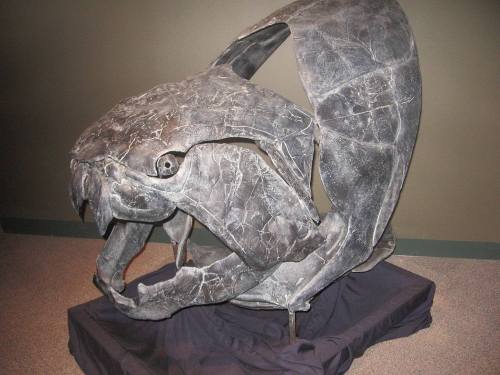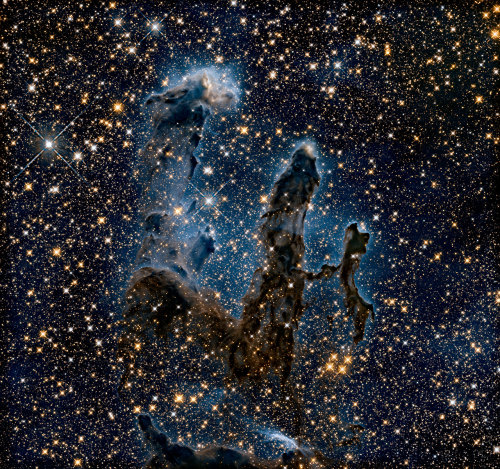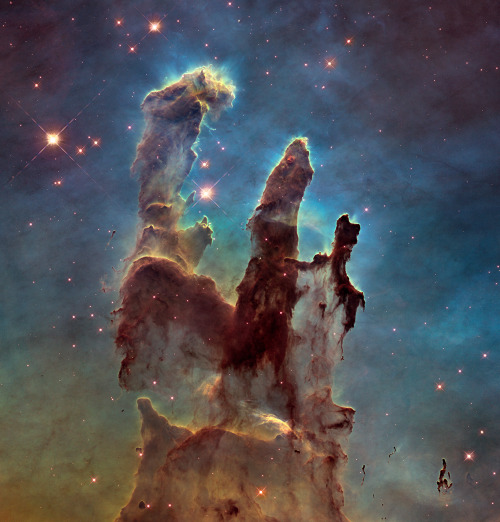Large Hubble Survey Confirms Link Between Mergers And Supermassive Black Holes With Relativistic Jets

Large Hubble Survey Confirms Link between Mergers and Supermassive Black Holes with Relativistic Jets by NASA Goddard Photo and Video
More Posts from Starry-shores and Others

Cassini Observes Sunsets on Titan (Artist’s Rendering) by NASA on The Commons
Crow, landing by me like one of those kinetic bombardment tungsten rods: I am ancient. I am all-seeing. I sat on the shoulders of gods, made friends with the wolf and picked clean the eyes of your brothers. I am the ever-shifting trickster and the croak at the back of Death's throat. I am darkness a-wing and night in the day.
Me: Baby! Your lunch is there, go mad.
Crow: ...
Me: ...
Crow: Ooh, raisins!
Hubble’s Guide to Viewing Deep Fields
They say a picture is worth a thousand words, but no images have left a greater impact on our understanding of the universe quite like the Hubble Space Telescope’s deep fields. Like time machines, these iconic images transport humanity billions of light-years back in time, offering a glimpse into the early universe and insight into galaxy evolution!

You’ve probably seen these images before, but what exactly do we see within them? Deep field images are basically core samples of our universe. By peering into a small portion of the night sky, we embark on a journey through space and time as thousands of galaxies appear before our very eyes.
So, how can a telescope the size of a school bus orbiting 340 miles above Earth uncover these mind-boggling galactic masterpieces? We’re here to break it down. Here’s Hubble’s step-by-step guide to viewing deep fields:
Step 1: Aim at the darkness
Believe it or not, capturing the light of a thousand galaxies actually begins in the dark. To observe extremely faint galaxies in the farthest corners of the cosmos, we need minimal light interference from nearby stars and other celestial objects. The key is to point Hubble’s camera at a dark patch of sky, away from the outer-edge glow of our own galaxy and removed from the path of our planet, the Sun, or the Moon. This “empty” black canvas of space will eventually transform into a stunning cosmic mosaic of galaxies.

The first deep field image was captured in 1995. In order to see far beyond nearby galaxies, Hubble’s camera focused on a relatively empty patch of sky within the constellation Ursa Major. The results were this step-shaped image, an extraordinary display of nearly 3,000 galaxies spread across billions of light-years, featuring some of the earliest galaxies to emerge shortly after the big bang.
Step 2: Take it all in
The universe is vast, and peering back billions of years takes time. Compared to Hubble’s typical exposure time of a few hours, deep fields can require hundreds of hours of exposure over several days. Patience is key. Capturing and combining several separate exposures allows astronomers to assemble a comprehensive core slice of our universe, providing key information about galaxy formation and evolution. Plus, by combining exposures from different wavelengths of light, astronomers are able to better understand galaxy distances, ages, and compositions.

The Hubble Ultra Deep Field is the deepest visible-light portrait of our universe. This astonishing display of nearly 10,000 galaxies was imaged over the course of 400 Hubble orbits around Earth, with a total of 800 exposures captured over 11.3 days.
Step 3: Go beyond what’s visible
The ability to see across billions of light-years and observe the farthest known galaxies in our universe requires access to wavelengths beyond those visible to the human eye. The universe is expanding and light from distant galaxies is stretched far across space, taking a long time to reach us here on Earth. This phenomenon, known as “redshift,” causes longer wavelengths of light to appear redder the farther they have to travel through space. Far enough away, and the wavelengths will be stretched into infrared light. This is where Hubble’s infrared vision comes in handy. Infrared light allows us to observe light from some of the earliest galaxies in our universe and better understand the history of galaxy formation over time.

In 2009, Hubble observed the Ultra Deep Field in the infrared. Using the Near Infrared Camera and Multi-Object Spectrometer, astronomers gathered one of the deepest core samples of our universe and captured some of the most distant galaxies ever observed.
Step 4: Use your time machine
Apart from their remarkable beauty and impressive imagery, deep field images are packed with information, offering astronomers a cosmic history lesson billions of years back in time within a single portrait. Since light from distant galaxies takes time to reach us, these images allow astronomers to travel through time and observe these galaxies as they appear at various stages in their development. By observing Hubble’s deep field images, we can begin to discover the questions we’ve yet to ask about our universe.

Credit: NASA, ESA, R. Bouwens and G. Illingworth (University of California, Santa Cruz)
Hubble’s deep field images observe galaxies that emerged as far back as the big bang. This image of the Hubble Ultra Deep Field showcases 28 of over 500 early galaxies from when the universe was less than one billion years old. The light from these galaxies represent different stages in their evolution as their light travels through space to reach us.
Step 5: Expand the cosmic frontier
Hubble’s deep fields have opened a window to a small portion of our vast universe, and future space missions will take this deep field legacy even further. With advancements in technologies and scientific instruments, we will soon have the ability to further uncover the unimaginable.


Slated for launch in late 2021, NASA’s James Webb Space Telescope will offer a new lens to our universe with its impressive infrared capabilities. Relying largely on the telescope’s mid-infrared instrument, Webb will further study portions of the Hubble deep field images in greater detail, pushing the boundaries of the cosmic frontier even further.
And there you have it, Hubble’s guide to unlocking the secrets of the cosmos! To this day, deep field images remain fundamental building blocks for studying galaxy formation and deepening not only our understanding of the universe, but our place within it as well.
Still curious about Hubble Deep Fields? Explore more and follow along on Twitter, Facebook, and Instagram with #DeepFieldWeek!
Make sure to follow us on Tumblr for your regular dose of space!


Savage 10 metre fish of the Silurian and Devonian Heavily armoured piscine torpedoes with fierce teeth roamed the oceans in the early days of fishes, in fact the Devonian era is called the age of fishes by palaeontologists as they had a huge burst of speciation and diversified to fill most marine ecological niches during this time. The now extinct (fortunately) class known as placodermi (plate skin in Greek) was the apex predator of these long gone waters, and thrived from 438 to 358 million years ago, dying out at the end Devonian mass extinction (one of the lesser ones).
Keep reading


Sometimes… there’s more than meets the eye. 👀 You’re looking at two very different takes on an iconic image.
Human eyes can see only a small portion of the range of radiation given off by the objects around us. We call this wide array of radiation the electromagnetic spectrum, and the part we can see visible light.
In the first image, researchers revisited one of Hubble Space Telescope’s most popular sights: the Eagle Nebula’s Pillars of Creation. Here, the pillars are seen in infrared light, which pierces through obscuring dust and gas and unveil a more unfamiliar — but just as amazing — view of the pillars. The entire frame is peppered with bright stars and baby stars are revealed being formed within the pillars themselves. The image on the bottom is the pillars in visible light.
Image Credit: NASA, ESA/Hubble and the Hubble Heritage Team
Make sure to follow us on Tumblr for your regular dose of space: http://nasa.tumblr.com.
oh my god. apparently during the making of the Voyager golden record they had to fly the recorder by commercial airlines to add some material onto the record last minute and they booked a seat for it under the name of Mr. Equipment


The Most Hardcore Period in Earth’s History, or the Permian, was preceded by a complete ecosystem collapse, and featured three different major mass extinction events - including the largest in earth’s history, the Great Dying, which lead to nearly all life on earth dying out.
During the Permian, all the land on Earth was in one supercontinent, called Pangea; and all the water was in one ocean, called Panthalassa. This meant that life intermingled and expanded all over the world, more so than it was able to in other periods (besides the Triassic, which also featured a single continent and a single ocean).

Pangea, and the Permian, was characterized by extremes. The beginning of the Period featured the end of the Karoo Ice Age - the poles were filled with ice caps, the center of the continent was dry, and temperature extremes were found throughout the land and ocean. The end featured multiple mass extinctions and a rapid warming of the continent, reaching the extreme heat of the Triassic period.

By @franzanth
The Carboniferous Rainforest Collapse was primarily caused by an intensification of that ice age - leading to the start of the Permian featuring dry, harsh, extreme climates. This time period featured the rapid diversification and specialization of some of the earliest animals adapted for a dry existence - prior to now, life almost entirely existed in the oceans, or in the forested and swampy world of the Carboniferous. This was the first truly dry time for (at least some) life.

By @alphynix
Olson’s Extinction marked a change from that initial habitat in the Cisuralian epoch to the next, the Guadalupian. As the world began to rapidly warm after the Karoo Ice Age ended, this lead to a major extinction of plants and vertebrates especially. The vertebrates would not fully recover before the Triassic; however, it did lead to many new forms, especially among synapsids, appearing in the new vacant environmental roles.

(By @paleoart)
The Capitanian Extinction was caused by the explosion of a moderately sized laval flow system, the Emeishan Traps, which lead to immediate global cooling followed by rapid global warming. This greatly affected ocean chemistry, making it far more acidic than previously. Many reef animals were killed by this extinction, in addition to brachiopods; many vertebrates were also affected.

(By @paleoart)
So the Permian was a hard, broken world when the Siberian Traps - one of the largest lava flows in Earth’s History, and one of the largest volcanic events known - exploded, leading to even more dramatic climate change and extremely rapid global warming. This lead to acidification of the ocean’s and a dramatic drop in ocean oxygen. Almost every group of organisms was dramatically affected, and this extinction was the largest known in Earth’s History, with between 85-96% of life on Earth dying out (and some researchers thinking it may have even been higher), leading to this extinction being dubbed The Great Dying. Many groups utterly disappeared, despite having been features of the entire Paleozoic Eon (the eon that the Permian was at the end of) - trilobites, eurypterids, “spiny sharks”, tabulate and rugose corals, and blastoids complete disappeared, as did many other groups. Brachiopods, Gastropods, Ammonites, Radiolarians, Foraminiferans, Crinoids, and most Parareptiles also went extinct, as did many synapsids and amphibians. It was an utter catastrophe.

(By @paleoart)
The Permian was a time of extensive hardship, dramatic changes, and extinction event after extinction event. Life was truly on the brink - just as it was beginning to settle into terrestrial existence. So new animals, from insects to amniotes to conifers, spent their school years in a prehistoric hunger games - and only a few species managed to reach the weirdness kiln of the Triassic.
Welcome to the Permian.
The Most Hardcore Period of Earth’s History.
my favorite genre of photo is “excited scientist lying down next to a very big fossil/animal/object/etc they have found to show off how big it is”
-
 dewiimelda liked this · 3 years ago
dewiimelda liked this · 3 years ago -
 remynx reblogged this · 3 years ago
remynx reblogged this · 3 years ago -
 remynx liked this · 3 years ago
remynx liked this · 3 years ago -
 bitterlydisappointing reblogged this · 4 years ago
bitterlydisappointing reblogged this · 4 years ago -
 wheresmyfuckingfood liked this · 4 years ago
wheresmyfuckingfood liked this · 4 years ago -
 thenictu liked this · 4 years ago
thenictu liked this · 4 years ago -
 maeganbobaegan liked this · 4 years ago
maeganbobaegan liked this · 4 years ago -
 outlawpetegsc liked this · 4 years ago
outlawpetegsc liked this · 4 years ago -
 dyskomike reblogged this · 4 years ago
dyskomike reblogged this · 4 years ago -
 dyskomike liked this · 4 years ago
dyskomike liked this · 4 years ago -
 siyahalbatros reblogged this · 4 years ago
siyahalbatros reblogged this · 4 years ago -
 ninojk reblogged this · 4 years ago
ninojk reblogged this · 4 years ago -
 xploseof reblogged this · 4 years ago
xploseof reblogged this · 4 years ago -
 2020ll liked this · 4 years ago
2020ll liked this · 4 years ago -
 mushroominfected liked this · 4 years ago
mushroominfected liked this · 4 years ago -
 8065537 reblogged this · 4 years ago
8065537 reblogged this · 4 years ago -
 montanagirlm reblogged this · 4 years ago
montanagirlm reblogged this · 4 years ago -
 mpaksbunny liked this · 4 years ago
mpaksbunny liked this · 4 years ago -
 mcbutter0420 liked this · 4 years ago
mcbutter0420 liked this · 4 years ago -
 myloveliveshere reblogged this · 4 years ago
myloveliveshere reblogged this · 4 years ago -
 xd--xdxd-xdxd-xd reblogged this · 4 years ago
xd--xdxd-xdxd-xd reblogged this · 4 years ago -
 xd--xdxd-xdxd-xd liked this · 4 years ago
xd--xdxd-xdxd-xd liked this · 4 years ago -
 deathsdarkscream reblogged this · 4 years ago
deathsdarkscream reblogged this · 4 years ago -
 sunkssdshawty liked this · 4 years ago
sunkssdshawty liked this · 4 years ago -
 crimson-blair reblogged this · 4 years ago
crimson-blair reblogged this · 4 years ago -
 stardust7 liked this · 4 years ago
stardust7 liked this · 4 years ago -
 volupianoturna reblogged this · 4 years ago
volupianoturna reblogged this · 4 years ago -
 holesinrealityy reblogged this · 4 years ago
holesinrealityy reblogged this · 4 years ago -
 artinwood54 liked this · 4 years ago
artinwood54 liked this · 4 years ago -
 whispersinthecosmos liked this · 4 years ago
whispersinthecosmos liked this · 4 years ago -
 jmh1974 liked this · 4 years ago
jmh1974 liked this · 4 years ago -
 lovemusicnart reblogged this · 4 years ago
lovemusicnart reblogged this · 4 years ago -
 elm-and-oak liked this · 4 years ago
elm-and-oak liked this · 4 years ago -
 justthishumanheart reblogged this · 4 years ago
justthishumanheart reblogged this · 4 years ago -
 justthishumanheart liked this · 4 years ago
justthishumanheart liked this · 4 years ago -
 paddy0121 liked this · 4 years ago
paddy0121 liked this · 4 years ago -
 crossedsardines liked this · 4 years ago
crossedsardines liked this · 4 years ago -
 coloursoflovelustlife liked this · 4 years ago
coloursoflovelustlife liked this · 4 years ago

Amateur astronomer, owns a telescope. This is a side blog to satiate my science-y cravings! I haven't yet mustered the courage to put up my personal astro-stuff here. Main blog : @an-abyss-called-life
212 posts

